|
|

|
|
Author
|
Topic: [SLS] Mobile Launcher construction updates
|
Robert Pearlman
Editor Posts: 52356
From: Houston, TX
Registered: Nov 1999
|
 posted 05-09-2008 01:15 AM
posted 05-09-2008 01:15 AM
   
NASA release NASA Awards Contract for Mobile LauncherNASA's Kennedy Space Center has awarded a contract to Hensel Phelps of Orlando, Fla., for the construction of a new mobile launcher for the Constellation Program. The contract includes an option for an additional mobile launcher. It is a firm fixed-price contract with a value of $263,735,000, if all options are exercised. The mobile launcher will support the next generation crew launch vehicle and its associated ground support equipment. It will be used in the assembly, testing and servicing of the vehicle at existing Kennedy facilities. The mobile launcher will transport the rocket to the launch pad and provide ground support for launches. The mobile launcher consists of the main support structure that comprises the base, tower and facility ground support systems, which include power, communications, conditioned air, water for cooling, wash-down, and ignition over-pressure protection. Hensel Phelps will supply all labor, materials and equipment necessary for construction of the mobile launcher. Ground support equipment, such as umbilicals, propellant and gases, instrumentation, controls and communications, necessary to support the rocket will be provided and installed under a separate contract or contracts. The tower of the mobile launcher will have multiple platforms for personnel access and will be approximately 390 feet tall. Construction will take place at the mobile launcher park site area located north of Kennedy's Vehicle Assembly Building at the space center in Florida. |
Robert Pearlman
Editor Posts: 52356
From: Houston, TX
Registered: Nov 1999
|
 posted 02-12-2009 09:16 PM
posted 02-12-2009 09:16 PM
   
NASA photo release Trestles and girders for a new mobile launcher arrive by barge February 12 at the Launch Complex 39 area turn basin of NASA's Kennedy Space Center.The new launcher will be lighter than space shuttle mobile launcher platforms so that the crawler-transporter can pick up the added load of the 345-foot tower and taller rocket. When the structural portion of the new mobile launcher is complete, umbilicals, access arms, communications equipment and command and control equipment will be installed. 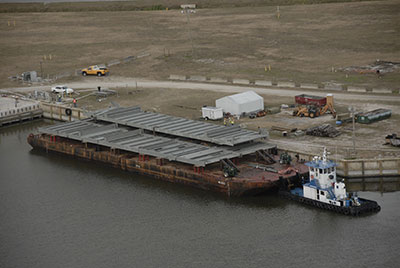 |
Robert Pearlman
Editor Posts: 52356
From: Houston, TX
Registered: Nov 1999
|
 posted 02-14-2009 12:06 PM
posted 02-14-2009 12:06 PM
   
NASA photo release After being offloaded from a barge at the turn basin at NASA's Kennedy Space Center in Florida, the girder for the new mobile launcher moves to the mobile launcher parking area behind the Vehicle Assembly Building. 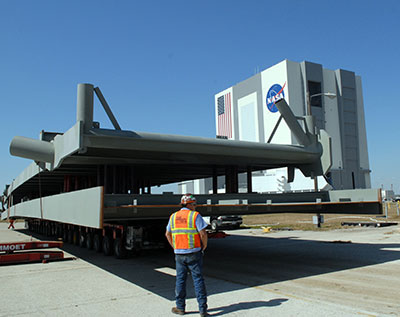 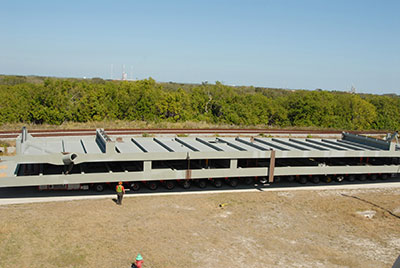
|
Robert Pearlman
Editor Posts: 52356
From: Houston, TX
Registered: Nov 1999
|
 posted 03-21-2009 02:40 PM
posted 03-21-2009 02:40 PM
   
NASA photo release At NASA's Kennedy Space Center in Florida, a new mobile launcher is under construction. 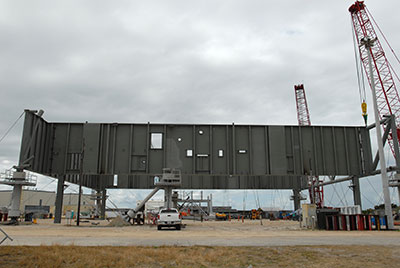 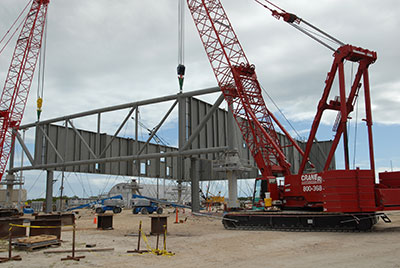
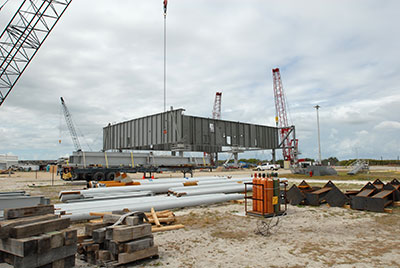
|
Robert Pearlman
Editor Posts: 52356
From: Houston, TX
Registered: Nov 1999
|
 posted 04-24-2009 09:29 PM
posted 04-24-2009 09:29 PM
   
Photographed on April 18, 2009 (credit: collectSPACE):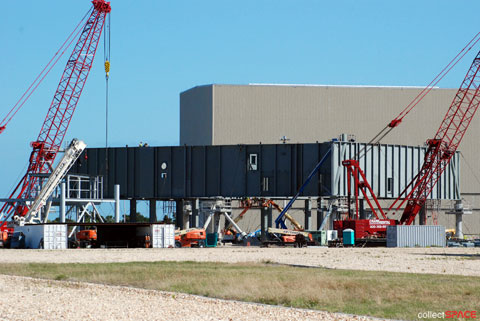 |
Robert Pearlman
Editor Posts: 52356
From: Houston, TX
Registered: Nov 1999
|
 posted 06-02-2009 09:50 AM
posted 06-02-2009 09:50 AM
   
NASA photo release In the mobile launcher parking area behind the Vehicle Assembly Building at NASA's Kennedy Space Center in Florida, the new mobile launcher, or ML, is under construction. 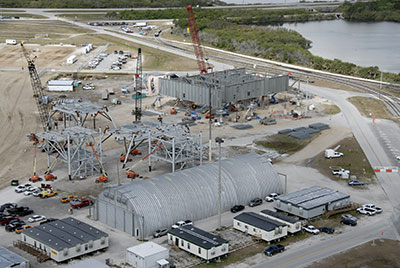 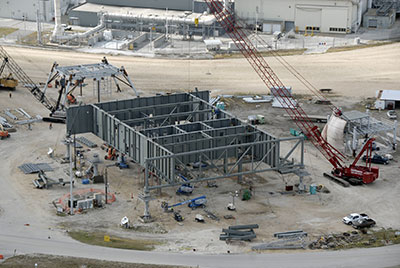
collectSPACE photos 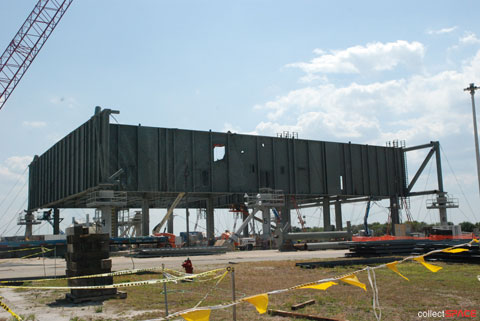 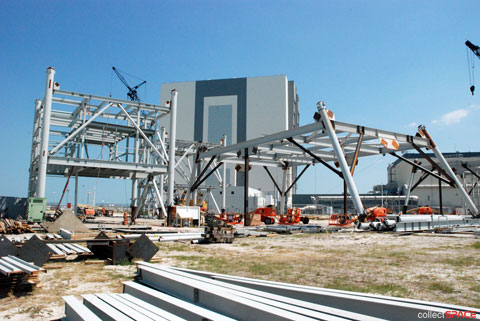
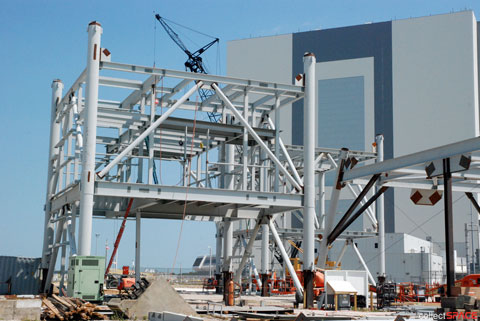
|
Robert Pearlman
Editor Posts: 52356
From: Houston, TX
Registered: Nov 1999
|
 posted 07-10-2009 11:30 AM
posted 07-10-2009 11:30 AM
   
NASA photo release At NASA's Kennedy Space Center in Florida, construction is under way on a new mobile launcher. 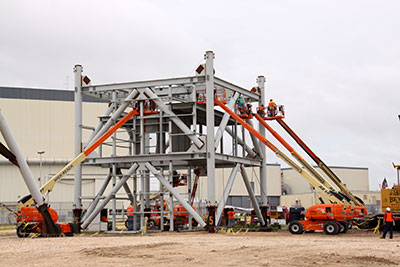 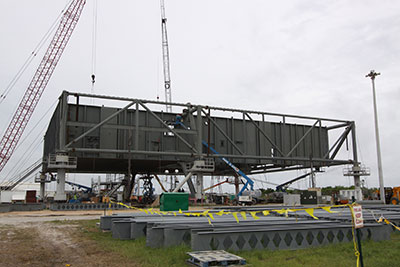
|
Robert Pearlman
Editor Posts: 52356
From: Houston, TX
Registered: Nov 1999
|
 posted 10-18-2009 01:36 AM
posted 10-18-2009 01:36 AM
   
NASA photo release At NASA's Kennedy Space Center in Florida, workers secure the second section of a tower for a new mobile launcher, or ML, to the first. Installation of the first section was on Sept. 24, 2009. The tower will have multiple platforms for personnel access and be approximately 345 feet tall. 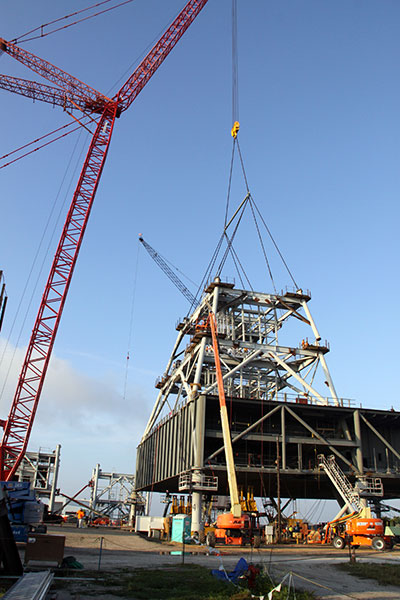 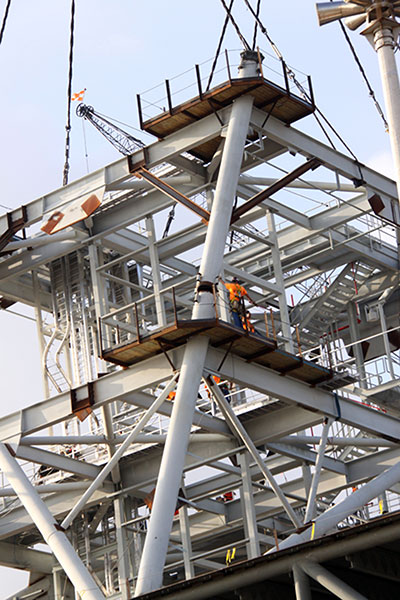
|
Robert Pearlman
Editor Posts: 52356
From: Houston, TX
Registered: Nov 1999
|
 posted 10-31-2009 06:47 PM
posted 10-31-2009 06:47 PM
   
NASA photo release At NASA's Kennedy Space Center in Florida, a crane lowers the third section of the tower for a new mobile launcher, or ML, into place atop the growing structure. 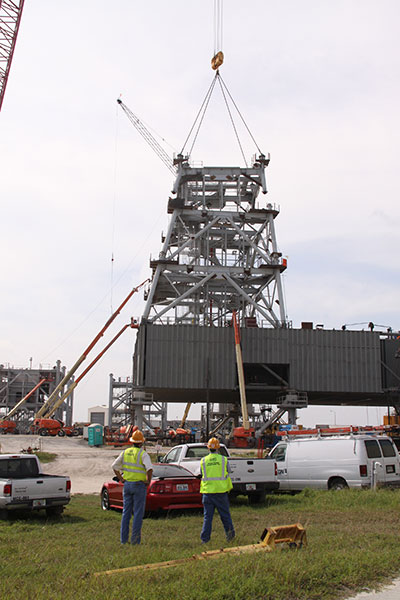 |
Robert Pearlman
Editor Posts: 52356
From: Houston, TX
Registered: Nov 1999
|
 posted 11-10-2009 10:51 AM
posted 11-10-2009 10:51 AM
   
NASA photo release At NASA's Kennedy Space Center in Florida, construction of the tower on a new mobile launcher, or ML, progresses. 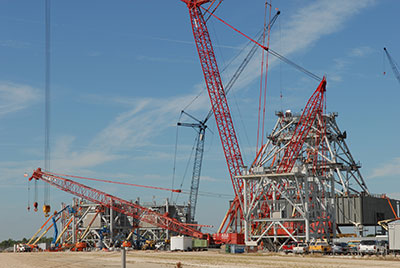 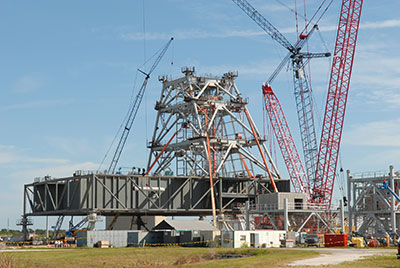
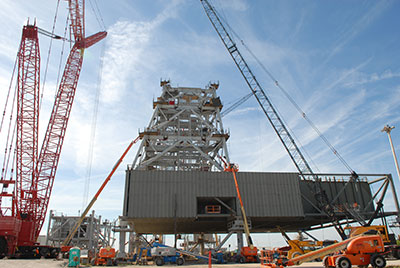
|
Robert Pearlman
Editor Posts: 52356
From: Houston, TX
Registered: Nov 1999
|
 posted 11-13-2009 04:46 PM
posted 11-13-2009 04:46 PM
   
NASA photo release At NASA's Kennedy Space Center in Florida, a crane lowers a fourth tower section onto three sections already secured to a new mobile launcher, or ML. 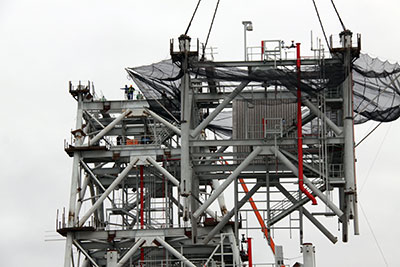 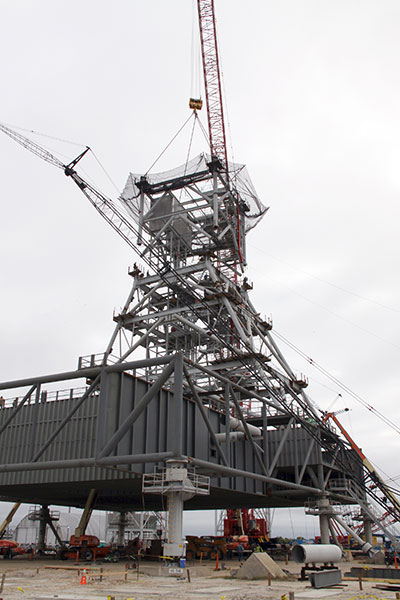
|
Robert Pearlman
Editor Posts: 52356
From: Houston, TX
Registered: Nov 1999
|
 posted 12-01-2009 04:42 PM
posted 12-01-2009 04:42 PM
   
NASA photo release At NASA's Kennedy Space Center in Florida, a crane positions a fifth tower segment onto four segments already secured to a new mobile launcher, or ML. 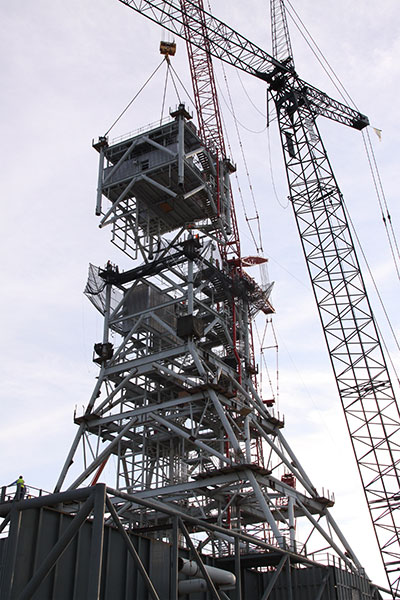 |
Robert Pearlman
Editor Posts: 52356
From: Houston, TX
Registered: Nov 1999
|
 posted 12-15-2009 09:02 AM
posted 12-15-2009 09:02 AM
   
NASA photo release At NASA's Kennedy Space Center in Florida, a crane positions a sixth tower segment onto five segments already secured to a new mobile launcher, or ML. 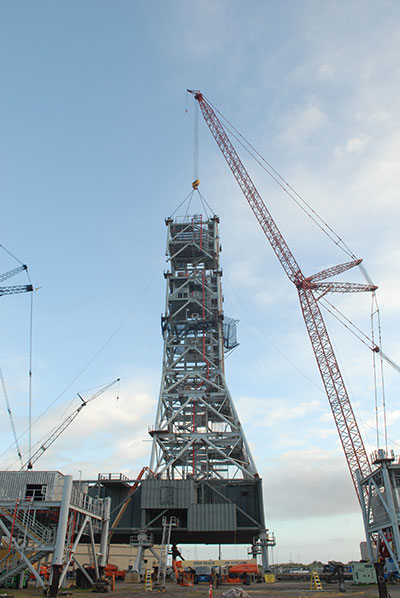 |
Robert Pearlman
Editor Posts: 52356
From: Houston, TX
Registered: Nov 1999
|
 posted 12-22-2009 11:44 AM
posted 12-22-2009 11:44 AM
   
NASA photo release At NASA's Kennedy Space Center in Florida, progress on the construction of the tower on a new mobile launcher, or ML, is apparent as the seventh tower segment is balanced in position. 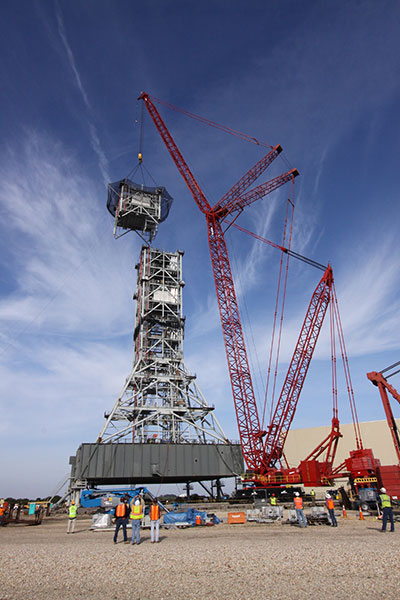 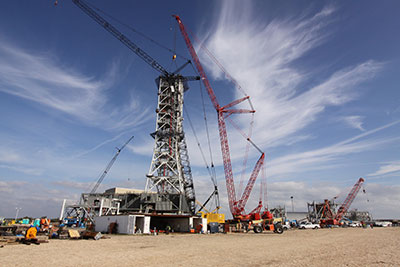
|
Robert Pearlman
Editor Posts: 52356
From: Houston, TX
Registered: Nov 1999
|
 posted 01-13-2010 05:30 AM
posted 01-13-2010 05:30 AM
   
NASA photo release At NASA's Kennedy Space Center in Florida, construction of the tower on a new mobile launcher, or ML, progresses with placement of the eighth tower segment on the growing structure. 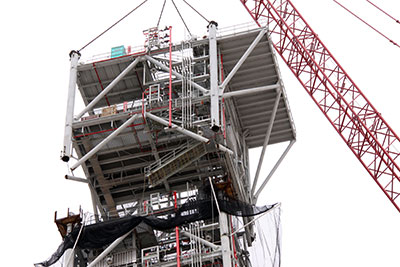 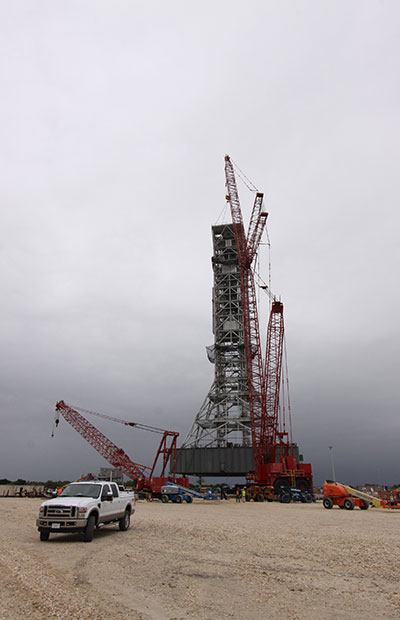
|
Robert Pearlman
Editor Posts: 52356
From: Houston, TX
Registered: Nov 1999
|
 posted 01-22-2010 09:27 AM
posted 01-22-2010 09:27 AM
   
NASA photo release At NASA's Kennedy Space Center in Florida, construction of the tower on the new mobile launcher, or ML, progresses with placement of the ninth tower segment on the growing structure. 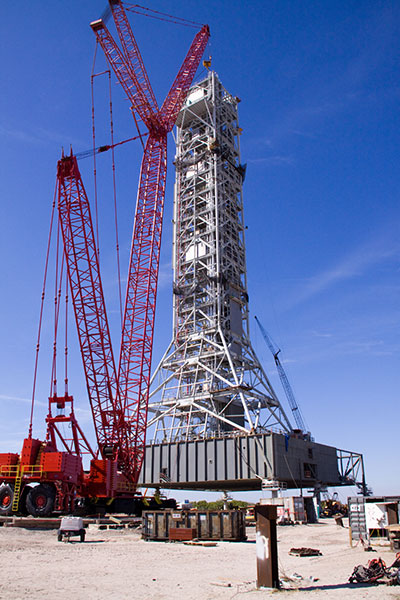 |
Robert Pearlman
Editor Posts: 52356
From: Houston, TX
Registered: Nov 1999
|
 posted 01-28-2010 10:03 AM
posted 01-28-2010 10:03 AM
   
NASA photo release Steel workers sign a signature plate and prepare a live, potted kumquat tree for a "topping out" ceremony to take place when the tenth and final tower section of the new mobile launcher is hoisted onto the tower later this week.In ancient Scandinavian society, the placement of an evergreen tree on a building's ridge pole signaled to all who helped with its construction that the celebration of its completion would begin. In this "green" version of the custom, the kumquat tree will be removed from the tower after the ceremony and planted.  
|
Robert Pearlman
Editor Posts: 52356
From: Houston, TX
Registered: Nov 1999
|
 posted 01-28-2010 06:39 PM
posted 01-28-2010 06:39 PM
   
NASA photo release At NASA's Kennedy Space Center in Florida, a crane gently lowers a tenth and final tower segment toward the nine segments previously secured to a new mobile launcher, or ML. 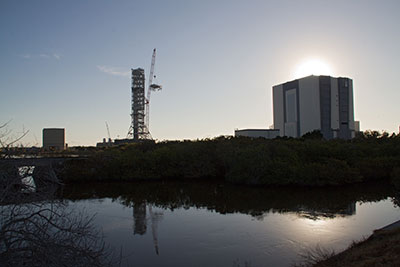 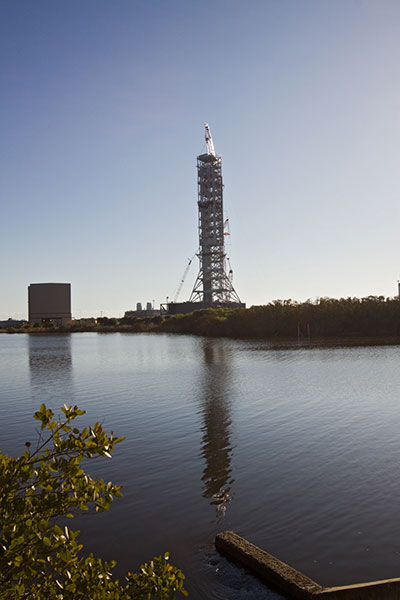
|
Robert Pearlman
Editor Posts: 52356
From: Houston, TX
Registered: Nov 1999
|
 posted 01-31-2010 09:12 AM
posted 01-31-2010 09:12 AM
   
NASA photo release At NASA’s Kennedy Space Center in Florida, a large crane has lowered the tenth and final segment of a new mobile launcher, or ML. 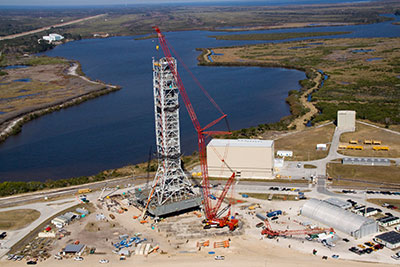 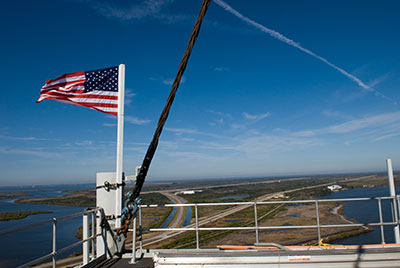
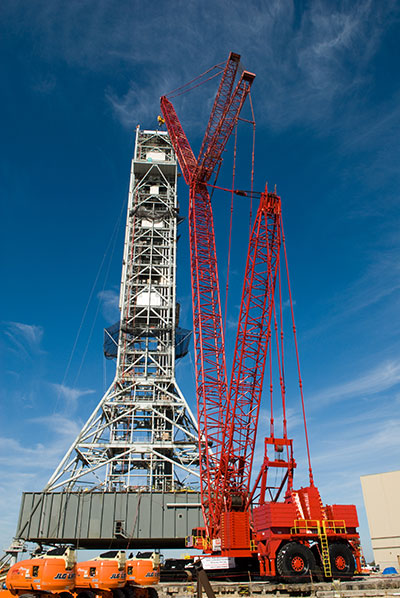
|
Robert Pearlman
Editor Posts: 52356
From: Houston, TX
Registered: Nov 1999
|
 posted 04-23-2010 05:28 PM
posted 04-23-2010 05:28 PM
   
NASA photo release At NASA's Kennedy Space Center in Florida, workers supervise the lift of the third segment of the launch mount for a new mobile launcher, or ML, being constructed to support NASA's future human spaceflight program from the tractor-trailer on which it arrived. 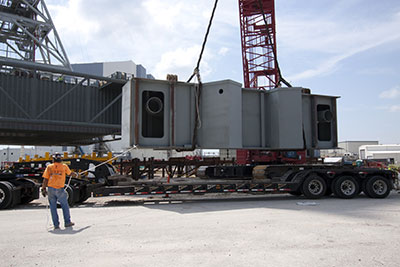 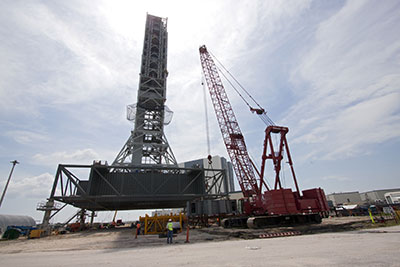
|
Robert Pearlman
Editor Posts: 52356
From: Houston, TX
Registered: Nov 1999
|
 posted 06-25-2019 04:35 PM
posted 06-25-2019 04:35 PM
   
NASA release NASA Awards Contract for Second Mobile Launcher at Kennedy Space CenterNASA has selected Bechtel National, Inc., of Reston, Virginia, to design and build a second mobile launch platform, known as Mobile Launcher 2 or ML2, for Exploration Ground Systems at the agency’s Kennedy Space Center in Florida. The cost-plus-award-fee end item contract has a total value of approximately $383 million. Bechtel National will complete the design, build, test, and commissioning of the mobile launcher within a 44-month period beginning July 1. ML2 is the ground structure that will be used to assemble, process, and launch NASA’s Space Launch System (SLS) Block 1B rocket and Orion spacecraft from Launch Pad 39B at Kennedy for missions under NASA’s Moon to Mars exploration approach. It will consist of a base structure, the platform for SLS, and a tower equipped with a number of connection lines called umbilicals, as well as launch accessories that will provide SLS and Orion with power, communications, coolant, fuel, and stabilization prior to launch. |
Robert Pearlman
Editor Posts: 52356
From: Houston, TX
Registered: Nov 1999
|
 posted 06-09-2022 02:39 PM
posted 06-09-2022 02:39 PM
   
NASA Office of Inspector General (OIG) release NASA's Management of the Mobile Launcher 2 ContractKey to NASA's goals of sustaining a human presence on the Moon and future exploration of Mars is development of the Space Launch System (SLS) — a two-stage, heavy-lift rocket that will launch the Orion Multi-Purpose Crew Vehicle (Orion) into space. NASA is developing two mobile launchers at Kennedy Space Center in Florida that will serve as the ground structure to assemble, process, transport to the pad, and launch various iterations of the integrated SLS/Orion system. The launchers consist of a two-story base structure — the platform to support the SLS — and a tower equipped with connection lines; launch accessories; and a walkway for personnel, equipment, and astronauts. In March 2020, the NASA Office of Inspector General issued a report examining development efforts for both mobile launchers. Construction of the first mobile launcher was completed in 2010 for the since-canceled Constellation Program's Ares I launch vehicle with the structure later modified to support the SLS/Orion system's first three missions known as Artemis. In 2019, NASA awarded a $383 million contract to Bechtel National, Inc. (Bechtel) to design, build, test, and commission a second mobile launcher (ML-2) to support larger variants of the SLS beginning with Artemis IV. In this audit, we examined the extent to which NASA is meeting cost, schedule, and performance goals for the ML-2 contract. To complete this work, we reviewed budget, contract, acquisition planning, schedule, program status, risk management, and award fee documentation and data from NASA and Bechtel. We also reviewed Earned Value Management System (EVMS) documentation provided by the Defense Contract Management Agency (DCMA) and conducted interviews with NASA, Bechtel, and DCMA officials. What we found NASA is estimated to spend approximately a billion dollars or at least 2.5 times more than initially planned for the ML-2 contract with final delivery of the launcher to NASA expected to take at least 2.5 years longer than initially planned. As of March 2022, NASA had obligated $435.6 million of Bechtel's current $460.3 million contract value and extended the contract's performance period 10 months. However, as of May 2022, design work on the ML-2 was still incomplete and Bechtel officials do not expect construction to begin until the first quarter of fiscal year 2023 at the earliest. To complete contract requirements and deliver an operational ML-2, Bechtel estimates it will need an additional $577.1 million, bringing the structure's total projected cost to $960.1 million coupled with an October 2025 rather than March 2023 delivery date. We expect further cost increases as inevitable technical challenges arise when ML-2 construction begins. Given the time NASA requires for additional testing once the structure is delivered, the earliest the ML-2 will be available for Artemis IV is November 2026. Compounding Bechtel's projected cost increases and schedule delays, an ML-2 project analysis provided only a 3.9 percent confidence level that the nearly $1 billion cost and October 2025 delivery estimates were accurate. NASA requires projects to develop budgets and schedules consistent with a 70 percent joint cost and schedule confidence level (JCL), meaning a 70 percent likelihood the project will finish equal to or less than the planned costs and schedule. In fact, an Independent Review Team analysis determined the project would require an additional $447 million and 27 months, for a total contract value of $1.5 billion and a launcher delivery date of December 2027—a schedule that would enable an Artemis IV launch no earlier than the end of 2028. Further, while the Exploration Ground Systems (EGS) Program, which manages the ML-2 project, established a formal Agency Baseline Commitment (ABC) for the overall EGS Program—the cost and schedule baseline against which a project is measured—NASA has not established a separate ABC for the ML-2, a recommendation we made in our March 2020 report. The ML-2's substantial cost increases and schedule delays can be attributed primarily to Bechtel's poor performance on the contract, with more than 70 percent ($421.1 million) of the contract's cost increases and over 1.5 years of delays related to its performance. For example, Bechtel underestimated the ML-2 project's scope and complexity, experienced ML-2 weight management challenges, and experienced staffing turnover and retention issues. Additionally, Bechtel's lack of a certified EVMS since inception of the ML-2 contract—a contractually required tool for measuring and assessing project performance—has limited NASA's insight into the project's cost and schedule issues. Bechtel's performance notwithstanding, NASA's management practices contributed to the project's cost increases and schedule delays. NASA awarded the ML-2 contract while the Exploration Upper Stage—the primary reason NASA needed a second mobile launcher—lacked final requirements, impacting the ML-2 design. With respect to contract management, while NASA withheld award fees for a 6-month performance period in spring 2021 due to Bechtel's poor performance, the Agency did not continue this practice despite the contractor's continued poor performance in the subsequent award period. Therefore, we question nearly $3 million in award fees NASA awarded to Bechtel for this period. During this audit, we urged NASA to take immediate corrective action given the substantial concerns surrounding Bechtel's performance. Bechtel has developed a recovery plan focused on addressing weight concerns and updating the We provided a draft of this report to NASA management who concurred with our recommendations and described their planned actions. We consider the proposed actions responsive and will close the recommendations upon completion and verification. project's cost and schedule, while NASA is assessing whether to transition to a fixed-price contract in the construction phase. It is too early to tell what impact, if any, these efforts will have on improving the trajectory of the project. Subsequent to the completion of our audit work, we learned the Agency rated Bechtel's performance for the award fee period ending in March 2022 as "unsatisfactory," resulting in no award fee for this period. Additionally, Bechtel developed a revised interim cost and schedule estimate that projected even higher contract costs and delivery of the ML-2 to NASA in late 2026—more than 3.5 years later than originally promised. While we did not evaluate Bechtel's revised cost and schedule estimate or award fee rating as part of this audit, we will examine both as we continue to monitor NASA's management of the ML-2 contract. What we recommended To improve NASA's management of the ML-2 contract and Bechtel's performance, we recommended the Associate Administrator for Exploration Systems Development Mission Directorate: (1) evaluate Bechtel's support for the updated estimate of cost and schedule at project completion and finalize negotiations for Bechtel's currently proposed cost increases and NASA's government-driven changes; (2) before completing and finalizing the ML-2 project-level ABC, update the JCL analysis to reflect realistic life-cycle cost and schedule estimates to ensure effective budgeting and management of the project; (3) to the extent that some or all of the Bechtel contract is converted to a fixed-price contract, ensure the Critical Design Review has been completed in accordance with NASA's life-cycle policies prior to conversion and an independent government cost estimateis established before entering into any new contractual agreements; and (4) ensure acquisition officials minimize the availability of award fees when contract modifications and value increases are the result of shortcomings in contractor performance and require documentation of the rationale for any award fees granted. To increase accountability and improve future selection and management of contracts, we recommended the Assistant Administrator for Procurement (5) issue policy guidance to reinforce current Federal Acquisition Regulation (FAR) and NASA FAR Supplement regulatory guidance for stopping or withholding payments to a contractor for significant deficiencies in business systems, such as the EVMS. We provided a draft of this report to NASA management who concurred with our recommendations and described their planned actions. We consider the proposed actions responsive and will close the recommendations upon completion and verification. |
Robert Pearlman
Editor Posts: 52356
From: Houston, TX
Registered: Nov 1999
|
 posted 06-09-2022 02:39 PM
posted 06-09-2022 02:39 PM
   
Bechtel statement: Mobile Launcher 2 is a critical piece of infrastructure that must support human spaceflight, and Bechtel is committed to successfully delivering it. The project has experienced significant cost and schedule growth beyond the original good faith estimates, which did not appreciate the project complexity and necessary change resulting from parallel design evolution of all launch systems.Unfortunately, the Inspector General's report does not provide a complete picture of what led ot the current situation, and we strongly disagree with the report's overarching conclusions on the primary causes of the cost increases. The report does not appreciate the significance of the impacts of necessary design changes in support of the Artemis IV mission; nor does it address the significant and ongoing impacts of the global pandemic; and it wrongly attributes significant price increases to poor project performance, including management of the mobile launcher weight, which is a unique engineering challenger that Bechtel and NASA engineers have resolved together. In partnering with NASA, we are now focused on reach 80 percent design completion before construction starts to establish a high confidence estimate of the full cost and schedule. We are very proud of the excellent joint team working to delivery ML-2, and we remain committed to supporting NASA and the Artemis program in the safest, most efficient way possible. |
Robert Pearlman
Editor Posts: 52356
From: Houston, TX
Registered: Nov 1999
|
 posted 05-10-2024 03:59 PM
posted 05-10-2024 03:59 PM
   
NASA release NASA's New Mobile Launcher Stacks Up for Future Artemis MissionsThe foundation is set at NASA's Kennedy Space Center in Florida for launching crewed missions aboard the agency's larger and more powerful SLS (Space Launch System) Block 1B rocket in support of Artemis IV and future missions. On May 9, 2024, teams with NASA's EGS (Exploration Ground Systems) Program and contractor Bechtel National Inc. transferred the primary base structure of the mobile launcher 2 to its permanent mount mechanisms using the spaceport's beast-mode transporter — the crawler. 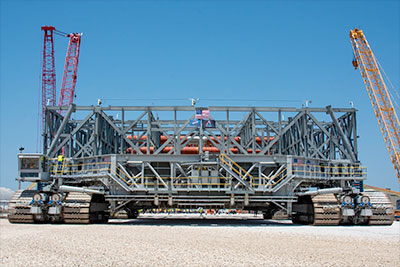 Above: On Thursday, May 9, 2024, teams with NASA’s Exploration Ground Systems Program and primary contractor, Bechtel National, Inc., continue moving the base structure of mobile launcher 2 to a permanent mount structure where assembly will be completed at Kennedy Space Center in Florida. (NASA/Madison Tuttle) "Seeing mobile launcher 2 take shape has been incredible," said Shawn Quinn, program manager for NASA's EGS Program. "Anytime we can see the manifestation of our work into physical hardware means a lot to the EGS team. It is also inspiring for the future of Artemis, with each bolt and truss put in place signifying the next phase of humanity's return to the Moon." Why is the "Jack & Set" process necessary? Teams at Bechtel fabricated temporary pedestals 8 feet off the ground, facilitating a much more efficient and safer initial steel build process by sitting lower to the ground. These extremely large steel truss subassemblies, some weighing over 100,000 pounds each, sat on temporary bases. Once the entire 2.6 million-pound skeleton of the base was fully torqued and welded, teams used a specialized heavy-duty jacking system to raise the base to allow sufficient space for the spaceport's crawler to be situated underneath the structure ahead of repositioning. Four self-propelled modular transporters were driven underneath the sides of the steel assembly and then lowered the base onto eight surrounding jacks. Once secured, teams removed the transporters and used jacks to raise the base 18 feet to allow for crawler access underneath the structure. The crawler was then positioned under the new base skeleton, raised the structure a few inches higher, and repositioned it about 200 feet to the six permanent pedestals, called mount mechanisms, completing the "jack and set" operation. "The jack & set milestone is a huge accomplishment for the NASA and Bechtel team," said Darrell Foster, ground systems integration manager for NASA's EGS Program. "It represents the hard work of hundreds of people – not only in the field putting the pieces together, but engineers and analysts who custom designed this structure, subcontracting buyers and delivery managers who drove the process to get the materials to the site, and the several offsite fabrication shops across the country." 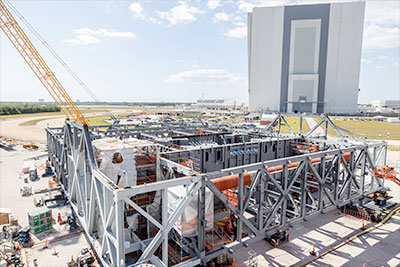 Above: With NASA’s iconic Vehicle Assembly Building in the background, teams with the agency’s Exploration Ground Systems Program and primary contractor, Bechtel National, Inc. continue construction on the base of the platform for the new mobile launcher at Kennedy Space Center in Florida on Wednesday, April 24, 2024. (NASA/Isaac Watson) Now poised atop the new launch mount mechanisms at its park site near the spaceport's Vehicle Assembly Building, teams will begin installing critical piping and electrical equipment inside the base. The mobile launcher will remain at the park site throughout the build and commissioning phases of the project. The mobile launcher serves as the primary interface between the ground launch systems, SLS rocket, and Orion spacecraft that will launch the SLS Block 1B rocket, with its enhanced upper stage, to the Moon, allowing the agency to send astronauts and heavier cargo into lunar orbit than its predecessor, SLS Block 1. With Artemis, NASA will land the first woman, first person of color, and its first international partner astronaut on the lunar surface and establish long-term exploration for scientific discovery and to prepare for human missions to Mars. | |
Contact Us | The Source for Space History & Artifacts
Copyright 1999-2024 collectSPACE. All rights reserved.

Ultimate Bulletin Board 5.47a
|
|

|
 advertisement advertisement

|



















































